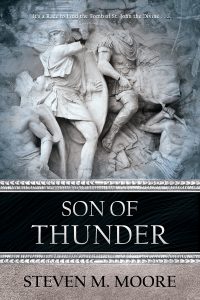Have a novel in you?
Don’t cripple it by trying to write it in a month! Even the venerable NY Times (yes, the newspaper that often has its names attached to “bestseller” in some arcane and suspicious indication of quality) bought into NaNoWriMo, or “National Novel Writing Month.” The challenge (and it belies the name a bit): Write a novel in a month. The best I can say about that nonsense is that it might motivate someone to get started writing. The worst? Continue on.
Most of you know I’ve written a few novels. I’ve never written one in a month! I’ve never met or corresponded with a serious writer who says she or he did this. It’s just not done. Maybe a short story or possibly a novella, but never a novel. While dependent on genre, a novel is a creation of at least fifty or more kwords (that’s 50,000 words—most are longer) that are not randomly placed on the page. Monkeys couldn’t have written Shakespeare’s plays; they can’t write novels either, because they’re much longer.
Of course, “serious writer” are two words to emphasize here. It took Michelangelo two years to sculpt David, the novel-equivalent in Renaissance art, chiseling away one chip at a time, even though he was an energetic twenty-year-old. I’m not pretending to compare genre fiction to that magnificent statue in the Uzzi, but no one can write a novel in a month. “Only 2000 words per day,” you say. Yeah, anyone can type 2000 words per day, but is anything of quality produced? Maybe you think that you just need to get the words down and afterwards you can turn a sow’s ear into a silk purse (adages like that shouldn’t be in your novel, by the way, unless one of your characters uses them in dialogue…a character trait exhibited by some people).
Even if you’re a pantser like me, which gets you going after you have some idea about plot and characters, writing a novel in one month isn’t equivalent to just typing 2000 words per day! (You don’t know what pantser means? One decision you have to make is whether to be a pantser or a plotter. The Times’s article focuses on writing software that almost enforces the latter, which can be more time consuming. I’m not going to debate the merits of either one. And did they count the time for the learning curve you have to climb to use the software?)
For some novels, I’m more “in the zone” in my writing than with others. I can type long stretches of prose almost semiconsciously as if the characters were whispering their own stories in my ear. That might produce days where I add up to 10 kwords to a novel. Those days are exceptional, and that zoned-out state often leads to prose requiring a lot of content editing.
“Oh, I don’t have to content edit. I can do that at the end. Or I’ll leave it to the editor.” Poor editor! If I were an editor, I’d refuse to edit a novel written so poorly that it’s an illogical mishmash of random thoughts, but you can work anyway you want to. Just remember: Content editing is only the first step in editing. Copy editing comes next before you even should contemplate submitting your one-month miracle. And there’s a lot more after that. And leaving all editing to the end can make your life miserable.
I guess my main problem with NaNoWriMo is that it trivializes the novel-writing process. Its hypothesis is that everyone has a novel in them, and they just have to dedicate some focused time to get it written. It’s not that easy, folks! While it can be a lot of fun, there’s a lot of mind-sweat and skills involved in writing, novel writing in particular.
So go ahead and try to write your novel, but do it at your own pace, enjoying the process, that uplifting feeling of creation. Just don’t put artificial constraints on yourself by joining in NaNoWriMo. If your novel is any good, you’ll have plenty of time to fret with schedules and deadlines afterwards!
***
Comments are always welcome.

Son of Thunder. Art Detective Esther Brookstone has a new obsession. Recently retired from Scotland Yard’s Art and Antiques Division, she becomes obsessed with finding the tomb of St. John the Divine following directions left in the frame of a painting by Renaissance artist Sandro Botticelli. Three parallel stories from three different eras—St. John’s clandestine missionary work, Botticelli’s own search for the tomb accompanied by his parish priest, and Esther’s search—all come together at the end.
Here’s one reviewer’s summary of the novel:
“Moore’s deft interweaving of history, religion, fable and fact makes for a fascinating read, highly recommended for readers who favor a thriller that makes them think beyond the page.”– Barbara Bamberger Scott, in her Feathered Quill review.
Available in print and ebook format at the publisher, Penmore Press, and Amazon, as well as in ebook format at Smashwords and all its affiliated retailers (iBooks, B&N, Kobo, etc.). You can also find it in you favorite local bookstore (if they don’t have it, ask for it).
Around the world and to the stars! In libris libertas!
